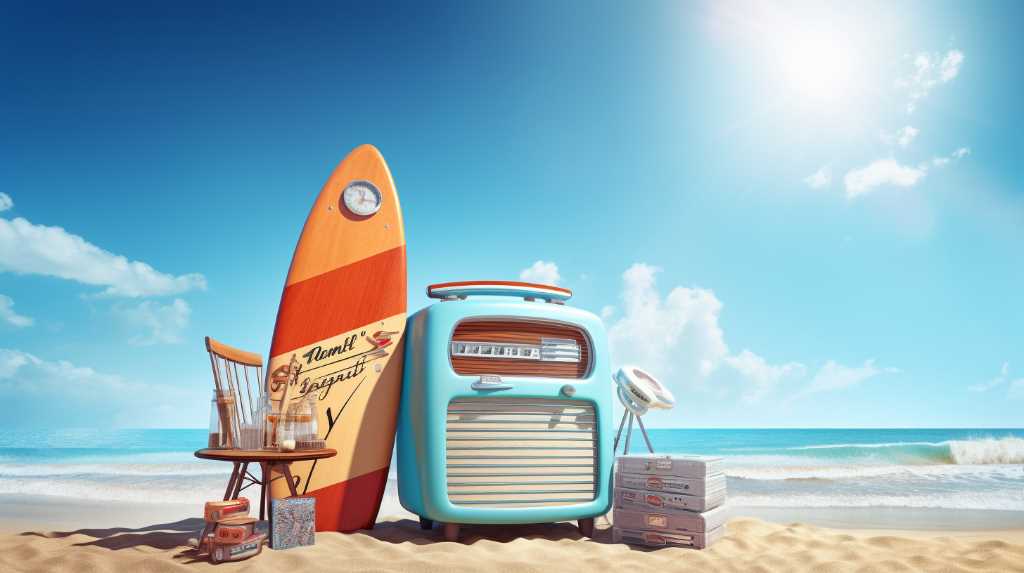
Surf blues music blends the laid-back vibe of surfing with the deep emotions of blues. This mix creates a sound that feels both relaxed and serious. It started when some musicians mixed the two styles together. This kind of music takes you on a special trip that combines fun with deeper thinking.
When we look into how surf blues began, talk about the famous musicians, and look at the key albums, we see how complex the guitar playing and live shows are – they’re as varied as the sea. But it’s not just about the techniques or history.
This music also tells a story about how the loud waves of the sea and the quiet parts of being human talk to each other. Let’s dive into the details of this interesting music style.
Origins of Surf Blues
Surf blues is a music style that started in the early 1960s. It combines the loud, twangy sounds of surf rock with the deep feeling of blues music. It came to life in California, where people loved the beach culture. Musicians used electric guitars to make sounds like the waves of the ocean. This new type of music wasn’t just about different sounds coming together; it showed how different American music styles could mix.
The expert playing of the guitar and the emotional power of the blues made a sound that was full of life and told real stories. Surf blues became popular because it captured the fun of surfing and the meaningful stories found in blues music.
Let’s break it down:
- Surf blues started in the 1960s, mixing surf rock and blues.
- It was inspired by the beach life in California.
- Electric guitars were used to mimic the sound of the ocean.
- It’s a mix of different American music styles.
- The guitar skills and emotional blues created a lively, story-telling sound.
- It became loved for its blend of fun and storytelling.
Iconic Surf Blues Artists
A few musicians have really left their mark on surf blues, a music style that combines the echoey guitar sounds of surf music with the deep feel of the blues.
Dick Dale is one of these key figures. He was amazing at playing the Fender Stratocaster guitar and he created the original surf guitar sound, which later artists used as a model.
For example, The Ventures mixed blues into their surf rock music, making songs that people still love today.
Bands like Los Straitjackets are also important because they keep making music that respects the old style but also tries new things. They use guitar sounds from surf music and mix them with the blues.
These artists are really important in the history of music because they helped shape the surf blues genre.
Essential Surf Blues Albums
When exploring surf blues music, a few albums really stand out because they perfectly mix the sound of electric guitars with a reverb effect and the slow, emotional rhythm of blues music. These albums are great examples of how artists carefully create guitar tunes and harmonica parts that really represent the surf blues style.
For instance, ‘The Breakers’ Blues’ by The Wave Riders gives you the feeling of being on the beach, where the blues mixes with the sound of waves.
Also, ‘Shoreline Sessions’ by Blue Tide combines classic blues with the lively beat of surf music in a way that shows how the genre has grown. These albums are important because they have helped shape what surf blues is today and prove that people still love this mix of music styles.
Let’s give you some specific examples. If you’re new to surf blues, start with ‘The Breakers’ Blues.’ Its standout tracks provide a vivid picture of the beach and ocean, setting the mood perfectly.
For a more upbeat experience, ‘Shoreline Sessions’ adds a faster pace to the bluesy tunes, making it a great follow-up album. These recommendations are tailored to give you a clear idea of the genre’s range and to help you dive deeper into surf blues.
Surf Blues Guitar Techniques
To get good at surf blues guitar, it’s important to know the rhythms and how to use the tremolo arm. The tremolo arm makes the guitar sound like ocean waves. This music is known for its echoey sound, which helps create a special mood. Players often go for a sharp, clear sound, which they get from single-coil pickups. This makes the music feel both old-fashioned and exciting.
Playing quickly back and forth between downstrokes and upstrokes is a key part of this style. This is called double picking. It needs you to be very precise and in control. Surf blues guitarists also use smooth techniques like hammer-ons and pull-offs a lot. This makes the music flow smoothly, just like waves in the ocean.
In simple terms, if you want to play surf blues guitar:
- Practice playing in time and learn to use the tremolo arm well.
- Aim for a sound that echoes, as this is essential for the right feel.
- Choose a guitar with single-coil pickups for that classic bright tone.
- Work on your double picking to get the speed and accuracy needed.
- Use hammer-ons and pull-offs to add smoothness to your playing.
Live Surf Blues Experiences
Surf blues guitar skills are crucial for creating the right sound, but it’s the live shows that really bring the music to life. The deep notes from the bass guitar fill the room, moving the crowd as they listen. At the same time, the guitar’s vibrating sound can make you feel like you’re in a calm, reflective state.
The drums keep a steady rhythm that reminds you of ocean waves, making everyone move together. This scene is special because it mixes feelings of good old days at the beach with the excitement of being at a concert right now.
When you go to a live surf blues show, it’s more than just listening to music. It’s about experiencing the music with all your senses. It’s like you’re part of a painting that’s being created with every music note, showing us a picture of the ocean.
Conclusion
Surf blues combines the upbeat tempo of surf rock with the deep emotion of blues music. This style has made a lasting impact on the world of music. It’s known for its unique sound, created by trailblazing musicians and influential albums. Today, skilled guitarists keep it alive, and its energy fills live shows. The lasting popularity of surf blues shows how much it matters in culture and how it captivates with its mix of lively tunes and soulful melodies.
Here’s why it’s special: Surf blues wouldn’t be what it is without the guitarists who’ve mastered its complex techniques. They’re the ones who bring the music’s spirit to life, especially during concerts. When you hear a surf blues song, you can feel the connection between the artists and the history they’re part of.
For anyone interested in this genre, check out albums by The Ventures or the guitar work of artists like Dick Dale. Their contributions have shaped surf blues, making it what it is today – a vibrant and influential part of music history.








